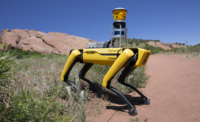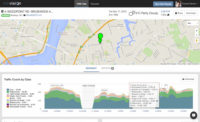Video, Still Camera Mounted on Sunglasses Allows for Hands-Free Site Documentation


Elizabeth Cox walked the site of the Houston Dynamo stadium wearing new sunglasses her brother gave her. When she got back to the work trailer, she had a high-definition video of her site walk. Her sunglasses, which come equipped with a built-in camera, recorded and auto-focused while she toured the facility.
“I wish I had these glasses eight months ago,” says Cox, who was project manager at the time. “I could have documented the whole thing.” The sunglasses are made by Pivothead, New York City, which was founded by Cox’s brother, Chris Cox; the company began production of the glasses that Cox wore on site late last year.
ENR reviewed the Recon model of the $349 sunglasses—one of several models offered—in July. We are quite impressed with the quality of video and the ease of use. Filming is as simple as wearing glasses, which is exactly what Chris Cox says he wanted when he dreamed them up.
“I thought, what if I could put a camera right between your eyes?” says Chris Cox. When researching the idea, he ran upon kids’ spy sunglasses that had a pinhole camera, he says.
Pivothead glasses are a significant improvement on spy gadgets. They feel as if you were wearing a regular pair of sports sunglasses, only a tiny bit heavier due to the electronics, which include an eight-megapixel camera, eight gigabytes of memory, a microphone for audio and a micro-USB port. There are four designs available in various color combinations. The video-record button on top of the frame's left arm is discreet and adjacent to a still-photo capture button that can shoot single shots or up to 16 rapid-fire photos.
“The obvious advantage is the hands-free aspect,” says Chris Cox. “On a construction site, that aspect alone is beneficial. What if you have tools or a clipboard or are climbing up a ladder?”
Software that comes with the glasses allows extensive programming of the camera when it is jacked into a USB port. It allows ISO adjustment, high-speed still-photo shooting, macro focus and image-quality adjustment. The glasses shoot video in 1,080-pixel at 30 frames per second (fps) or 720 pixels at either 60 fps or 30 fps. A time-and-date stamp also can be enabled for both photos and video. There is also a face-finder mode that will auto-focus on faces. The camera seems similar to the camera on newer iPhone models.
“Our glasses can be set up to pick out very fine details,” says Chris Cox, describing the macro setting, which can be used to get very close, in-focus video. The macro feature sets the glasses apart from wearable HD sports cameras such as the GoPro, which offers only a 3-ft-to-infinity focus setting.
Cox says that, by August 15, the Recon model will have customized prescription-lense options that are ANSI Z87.1 impact-rated. An optometrist can outfit three of the current models with prescription lenses. Another model, the Chameleon, comes with photochromic lenses—that is, they darken in the sun. All the glasses have four different focus settings: continuous, macro, auto and fixed. They also can be set for low light levels or to capture a time lapse.
“We’re testing live-streaming HD now,” says the Pivothead founder. That option should be available this fall, he says.
ENR Transportation Editor Aileen Cho is eager to get her hands on a pair for filming on jobsites, and we are vetting the glasses for that purpose now.





